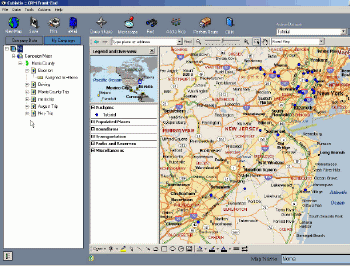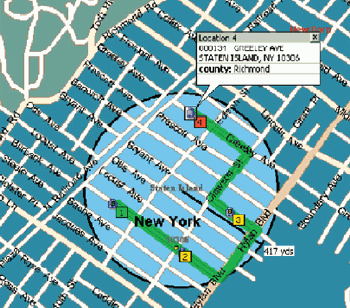 Distributor
DistributorCubistix, Inc.
PO Box 864
Lodi, NJ 07644
www.cubistix.com
Pricing
The cost of the Cubistix CRM Front End is $300 per single license.
Introduction
Customer Relationship Management (CRM) is recognized as one of the most critical issues in contemporary business. CRM is both a business strategy and a technology. CRM tools are usually quite complex since they integrate various aspects of management and require extensive data about customers. The market for operational and analytical CRM grows exponentially, and numerous CRM software packages are available at different price ranges.
One of the most popular and affordable systems, Microsoft Business Solutions CRM (about $2,000 per single license), was released two years ago. This CRM system is integrated with MS Office, MS Business Solutions for Financial Management, and other Microsoft business systems. This user-friendly software package can be accessed from MS Office Outlook and works both online and offline. The major components of this system are CRM Sales and CRM Customer Service. CRM Sales includes measuring and forecasting sales, tracking customer communications, automating stages in the sales process, territory management, leads and opportunity management. CRM Customer Service Capability incorporates assigning, managing and supporting incidents with automated routing, queuing, and escalation of service requests, identifying top customers, prioritizing service needs, knowledge base management, viewing accounts, sales, orders, and support information. CRM Mobile 1.2 serves the users of a Pocket PC or Pocket PC Phone Edition with Windows Mobile 2003.
Background
Much critical information in business is geographically related and location-based (some experts believe that to be true in 80% of cases). This is especially true for early adopters of CRM technology, including such major American cities as Chicago, Dallas, and Baltimore, where CRM stands instead for Citizen Relationship Management systems. While the final goal of CRM systems in business is to minimize costs and maximize sales, the purpose of Citizen Relationship Management in government is to enhance service to residents and to optimize the use of resources in the community. In both uses of CRM, location is a critical factor.
CRM tools are not suitable for taking full advantage of location-based data. Therefore, it becomes necessary to combine CRM with more a specialized tool – GIS. Some attempts have been made to combine CRM and GIS. For example, in 2000, GIS vendor Akanda Solutions LLC and CRM vendor JPH International Inc. tied together customer and geographic information via a Web interface. In 2003, DeltaDator integrated its Customer Pro CRM with SinerGIS. Five years ago, GIS leading vendor ESRI Inc. initialized cooperation with a CRM vendor. Also ESRI products were integrated with Connected Retailer CRM software from STS, an NSB company.
One of the most successful products representing so-called Spatial CRM was PinPoint, which was released by SRC, a vendor that also launched such packages as Allocate, Solocast and Portfolio. For less than $5,000, PinPoint enables very efficient and user-friendly data cleansing and transformation, including geocoding and other spatial operations. The same vendor (SRC) had supplied the technology for MapInfo’s TargetPro, the GIS/business software package, positioned as an “adjunct CRM.” MapInfo is also integrated with another CRM product, Siebel 7. Despite many successful implementations in all of these CRM/GIS marriages, only a small fraction of GIS functionality has been utilized.
Microsoft has been approaching the CRM/GIS market from another side by offering a low-cost GIS software package, MapPoint. This package integrates maps, demographic and geographic data for making business solutions. Three years ago, Microsoft made a deal with Simmons Market Research Bureau to deliver its National Consumer Study database via the MapPoint Data Service to Excel users (See Joe Francica's article “Excel-erating to a New Level of Spatial CRM” from November, 2002). It was a matter of time to take the next logical step and establish a link between two Microsoft products, one representing CRM and another GIS: Business Solutions CRM and MapPoint. The list of third-party vendors enhancing the Microsoft Business Solutions CRM is very long. However, none of them offers GIS functionality to CRM.
Front End
In 2002, a partnership was signed between Microsoft and Cubistix, a software company founded in 2002 and located in New Jersey, to develop a geographical front end system based on MapPoint API’s for a soon to be released Business Solutions CRM package. As a result of this partnership, the Cubistix CRM Front End version 1.0 was released in 2003 and version 2.0 was released in August 2004. This product is a very important link connecting three technologies: GIS, Business Intelligence (BI), and CRM. Cubistix Front End CRM integrates location and CRM data with a very intuitive geographic interface. This software is a great tool for such operations as site management, lead management, selecting sales and market penetration strategies, sales force automation, and measuring market potential. The cost of the Cubistix CRM Font End is only $300 per single license. The software requirements include the installment of the following five products:
- Microsoft Business Solutions CRM
- Microsoft Office 2003
- Microsoft MapPoint 2004
- Microsoft SQL Server
- Microsoft .net Framework 1.1
Business information is usually confidential, and therefore the software provides the required security controls including login procedures for various access levels. Transfer data on competitors, contacts, invoices, etc. from the Microsoft CRM system to Front End is managed by using an efficient SQL builder. The Data System Manager allows the user to browse databases, individual tables, their fields and associate non-spatial fields with geographic fields for further mapping.
In addition to its core geographic operations, Front End also provides extensive non-spatial functionality including such critical issues as saving data in XML format, merging data and exporting results to Microsoft Word, generating reports in the form of Word tables, or creating letters and e-mails using CRM data.
Possible enhancements for this software package may include such operations as better thematic mapping, touring, allocation, redistricting, exporting maps to basic GIS formats, and using ODBC in the Data System Manager. Some terminology should be defined (campaigns) or corrected (library of shapes).
Front End represents an invaluable software solution for any user dealing with business information, including numerous CRM users, GIS users, and, most importantly, Microsoft users. The combo of Microsoft Business Solutions CRM, Microsoft MapPoint and Cubistix Front End CRM, constitutes an affordable solution in the CRM/GIS market. Future developments within any component of this combination will enhance the value of other components. Technological trends indicate future developments in the Internet-based CRM (so-called e-CRM) and on the integration of CRM, ERP (Enterprise Resource Planning) and GIS.

